

Do small and innovative firms need “structure”? - Organization (re)Design. Rewriting The Future Of Work: 8 Movements To Watch. Five Horizons of Systems Mastery. What does it take to become a rounded… In common parlance ‘systems thinking’ is understood as ‘thinking in systems’ (as the title of Donella Meadows’ posthumously published, widely read book suggests).
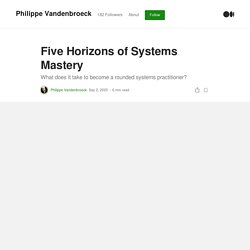
It relies on systems concepts — such as stocks, flows, feedback loops, network and hierarchy — to structure the problem solving process in relation to particular design challenges. ‘Systems practice’ goes beyond that. It is ‘systems thinking and doing’, or ‘system praxis’. How top companies use resilience strategy to survive and thrive through downturns. In this episode of the Inside the Strategy Room podcast, two McKinsey partners share their insights on preparing organizations for macroeconomic crises.

In their conversation with Strategy & Corporate Finance communications director Sean Brown, they also explain why the next downturn may be very different from earlier ones. (This is an edited transcript. For more conversations on the strategy issues that matter, subscribe to the series on iTunes or on Google Play.) Audio Podcast transcript Sean Brown: Welcome to Inside the Strategy Room. Being Regenerative: Your Key to Flourishing in the Future.
A Better Way to Grow: The Ever-Regenerative, People-Centered Enterprise. When Dulbecco saw Torani was ready for a new vision for a new era of regenerative change (shifting from selling primarily in cafes to broadening the reach to consumers first through retail strategy, then in designing around consumers), she did some soul-searching to determine if she felt she were truly the right person to lead Torani into the next, unpredictable new era.
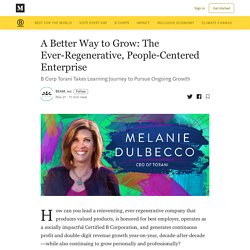
She had to clearly assess her skills and abilities, envision herself in the new era, determine what it meant to her own growth, and consciously make the decision to perhaps risk personal and company success to take on a new approach to business growth. None of this is easy, but it is necessary. “Growth and comfort do not co-exist.” — Ginni Rometty, CEO IBM As Dulbecco had done before in making transformational change, her response was to adopt and model for her team a new mantle of courageous change leadership that would lead Torani into new and unproven territory. Contribution Management Career Mixology. Een sociale investering levert voortaan geld op — Achtergrond — Sociaal.Net. Groot nieuws enkele maanden geleden: 270 werkloze Antwerpse jongeren zullen codeerlessen krijgen om hen aan een IT-job te helpen.
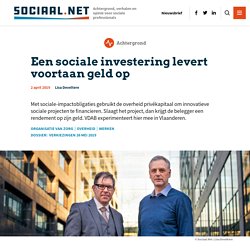
Het project op zich is niet zo opmerkelijk, wel hoe het gefinancierd wordt: met een sociale-impactobligatie. (146) Interview Kurt Peleman - Zwijgen is geen optie. IKEA lanceert duurzaamheids-app. De was aan de wasdraad drogen, koffie drinken die UTZ-gecertificeerd is of items kopen die gemaakt zijn uit gerecycleerd materiaal – het zijn kleine aanpassingen die onze levensstijl net dat tikje duurzamer maken, volgens de Zweden.

De app toont voor elke actie ook de impact op het klimaat. The Four System Conditions of a Sustainable Society. Left to its own devices, the earth is a sustainable system.
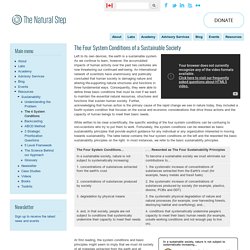
As we continue to learn, however, the accumulated impacts of human activity over the past two centuries are now threatening our continued well-being. An international network of scientists have unanimously and publically concluded that human society is damaging nature and altering life-supporting natural structures and functions in three fundamental ways. Consequently, they were able to define three basic conditions that must be met if we want to maintain the essential natural resources, structures and functions that sustain human society. Further, acknowledging that human action is the primary cause of the rapid change we see in nature today, they included a fourth system condition that focuses on the social and economic considerations that drive those actions and the capacity of human beings to meet their basic needs.
Design for Sustainability online course. While your personal preferences and professional background may draw you to certain dimensions of the curriculum more than others, we invite you to consider the importance of integrative whole systems design very carefully.
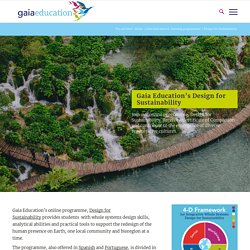
Responsible leadership and strategic CSR – Global Responsibility. Introducing the SDG Training of Multipliers, the SDG Flashcards and the SDG Canvas. In December 2016 — a little over a year after the launch of the United Nations’ ‘Sustainable Development Goals’ (SDGs) and ‘Agenda 2030’ — Gaia Education launched a day-long workshop format supported by a facilitation tool called the ‘SDG Implementation Flashcards.’

The ‘Training of Multipliers’ and the flashcards aim to promote cross-sectorial civic participation in the implementation of the SDGs at local, (bio)regional and sub-national scale. Defining my own design brief for a tool and process to spread conversations aimed at locally meaningful SDG implementation In my role as ‘Head of Design & Innovation’ for Gaia Education, I was asked to develop a new one-day training to promote SDG implementation at the scale of communities, organizations and businesses.
Kate Raworth: A healthy economy should be designed to thrive, not grow. Building capacity for systemic transformation to help realise the SDGs. Our economy is a degenerative system – Age of Awareness. “What is 120 times the size of London?
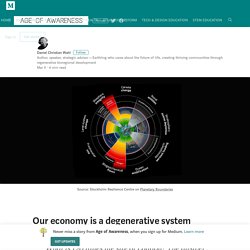
The answer: the land or ecological footprint required to supply London’s needs.” — Herbert Giradet Our ecological footprint exceeds the Earth’s capacity to regenerate. A number of useful indicators and frameworks have been developed to measure the ecological impact that humanity and its dominant economic system with its patterns of production, consumption and waste-disposal are having on the planet and its ecosystems. The measure and methodology for ecological footprinting translates the resource use and the generation of waste of a given population (eg: community, city, or nation) into the common denominator of bio-productive land per person, measured in Global Hectares (Gha), that are needed to provide these resources and absorb those wastes.
Deep Weaving: indigenous Earth wisdom, mythology, and cosmology. Weaving is inter-generational, making deep ties visible between generations alive today and their far distant ancestors.

Weaving is inter-species, reconnecting us to what makes us truly human — our membership in the community of life as a planetary process. “Caught up in a mass of abstractions, our attention hypnotized by a host of human-made technologies that only reflect us back to ourselves, it is all too easy for us to forget our carnal inherence in a more- than-human matrix of sensations and sensibilities. Our bodies have formed themselves in delicate reciprocity with the manifold textures, sounds, and shapes of an animate earth — our eyes have evolved in subtle interaction with other eyes, as our ears are attuned by their very structure to the howling of the wolves and the honking of the geese.
. — David Abram, The Spell of the Sensuous As D.H. Building capacity for systemic transformation to help realise the SDGs. The hidden value of organizational health. New research suggests that the performance payoff from organizational health is unexpectedly large and that companies have four distinct “recipes” for achieving it. For the past decade, we’ve been conducting research, writing, and working with companies on the topic of organizational health. Our work indicates that the health of an organization is based on the ability to align around a clear vision, strategy, and culture; to execute with excellence; and to renew the organization’s focus over time by responding to market trends.
Health also has a hard edge: indeed, we’ve come to define it as the capacity to deliver—over the long term—superior financial and operating performance. In previous articles and books, such as Beyond Performance, we (and others) have shown that when companies manage with an equal eye to performance and health, they more than double the probability of outperforming their competitors. How we track health Management practices matter Implementing a healthy recipe. Transformative Change: conversations with Fritjof Capra. On Monday, January 29th, 2018, Gaia Education and Fritjof Capra’s ‘Capra Course’ collaborated in offering a free webinar on ‘Transformative Change, Sustainability and Regeneration’ as part of our recently launched ‘Glocalisers Webinar Series’.
I am delighted to have been able to weave this partnership as so much of my own learning that has informed the content of Gaia Education’s online course in ‘Design for Sustainability’ (GEDS) has been influenced by Fritjof’s work (see also ‘In gratitude to Fritjof Capra’). There is a natural synergy between the courses offered by Gaia Education and the Capra Course. A lesson in regenerative agriculture from the Loess Plateau - Lush Fresh Handmade Cosmetics UK.